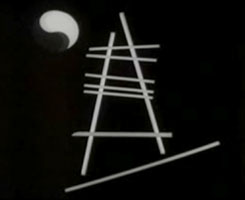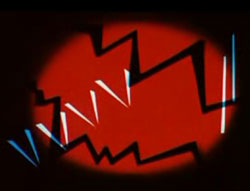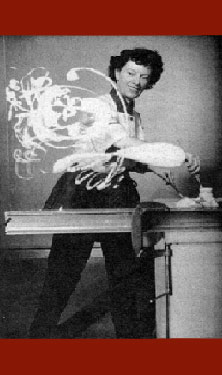 Mary Ellen Bute (1906-1983) was America's first abstract filmmaker, generally assisted by her partner Ted Nemeth, though priciple photography is always hers. Mary Ellen Bute (1906-1983) was America's first abstract filmmaker, generally assisted by her partner Ted Nemeth, though priciple photography is always hers.
Typical of her films of "music made visual" is the five-minute Rhythm in Light (1934).
Cardboard constructions, crinkled cellophane, & bracelet hoops are photographed mostly in soft-focus or entirely out of focus, reducing them to shadows, as they turn & bend in moving light, in time to Edvard greig's "The Peer Gynt Suite."
Shooting through prisms furthers the abastraction of the simple objects. Toward the end sparklers are filmed as a simple attempt at a climax.
 Text appearing at the beginning of the film regards the visual component as "abstract accompaniment" for the music, alleging to be "a pioneer effort in a new art form" to reveal what artists see when listening to music. Text appearing at the beginning of the film regards the visual component as "abstract accompaniment" for the music, alleging to be "a pioneer effort in a new art form" to reveal what artists see when listening to music.
As it is really not different from earlier films of Hans Richter & others, claims to pioneer status may be exaggerated. Overreaching claims aside, it's a pleasant little film.
Similarly, light filmed through glass colonders makes up the bulk of her six-minute "seeing sound' film Synchromy No. 2 (1936).
The result is often ornate & appealing but as an extension of the music it seems more a distraction than an addition to Richard Wagner's "Evening Star."
 Backed by the music of Darius Milhand from "La creation du Monde," Parabola (1936/38) is a one-reel experimental film of sculptured shapes mounted on rods & filmed as they seem to fold & unfold on a turntable. Backed by the music of Darius Milhand from "La creation du Monde," Parabola (1936/38) is a one-reel experimental film of sculptured shapes mounted on rods & filmed as they seem to fold & unfold on a turntable.
They're actually static objects but shadows cause them to move, & the interplay of light & form quite interesting for what it says of film's unique capacity to give life to inanimate things.
The sculptures are by Rutherford Boyd, the primary photography by Mary Ellen Bute. As an experiment in "the poetry of motion" it was another project claiming to make music visible. Several avant garde filmmakers were doing this in the 1930s & even before, so it wasn't all that novel. But it's well done.
However, at nine minutes length, it felt at least four minutes too long. It builds nicely to the center & only becomes tiresome thereafter.
 At a scant two minutes, Dada (1936) is one of Bute & Nemeth's more winning films, because its length can leave one wanting more, unlike Parabola which at nine minutes tested patience. At a scant two minutes, Dada (1936) is one of Bute & Nemeth's more winning films, because its length can leave one wanting more, unlike Parabola which at nine minutes tested patience.
The reason it's so short is that it was made specially for a Paramount newsreel segment on Bute & Nemeth making films in their teency New York apartment. Paramount apparently never got round to including the filmmakers in any newsreel, but their own film survived in the Bute-Nemeth Archive.
Another "music made visual." we're treated to images of straws, hoops, triangles & blocks flying, bouncing, or dancing, white on black background. As these shapes arrange themselves into various patterns, it's kind of like Ziegield girls viewed from above making kalaidescope designs with their bodies, only there are no bodies. Dada is really quite lovely.
 For music by Erwin Gerschefski, in the four-minute Tarantella (1940), Bute solicited the assistance of animator Norman McLaren to bring forth another of her music-into-vision pieces, this time with use of color.
For music by Erwin Gerschefski, in the four-minute Tarantella (1940), Bute solicited the assistance of animator Norman McLaren to bring forth another of her music-into-vision pieces, this time with use of color.
Even the opening credits blink & swing closer to the camera & further away in time with the piano.
It comes off as a musical light show of the stoned hippy generation & easy to imagine a gathering of toking space cadets with enlarged pupils going, "Far out man, groovy." But some of it is harsh enough to frighten the ones on LSD.
A minor work whether assessed as cinema or as animation, Tarantella too closely resembles the works of Len Lye to regard any of it as innovative, just as her black & white films too much resembled the earlier works of Hans Richtor. Tarantella nevertheless has definite appeal, & the music is astounding of type.
copyright © by Paghat the Ratgirl
|


 Text appearing at the beginning of the film regards the visual component as "abstract accompaniment" for the music, alleging to be "a pioneer effort in a new art form" to reveal what artists see when listening to music.
Text appearing at the beginning of the film regards the visual component as "abstract accompaniment" for the music, alleging to be "a pioneer effort in a new art form" to reveal what artists see when listening to music.

